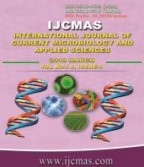


 National Academy of Agricultural Sciences (NAAS)
National Academy of Agricultural Sciences (NAAS)

|
PRINT ISSN : 2319-7692
Online ISSN : 2319-7706 Issues : 12 per year Publisher : Excellent Publishers Email : editorijcmas@gmail.com / submit@ijcmas.com Editor-in-chief: Dr.M.Prakash Index Copernicus ICV 2018: 95.39 NAAS RATING 2020: 5.38 |
A field experiment was conducted at the Regional Coffee Research Station, Diphu, Assam during 2016 and 2017 for effective management of Mikania micrantha in young robusta coffee plantation. The experiment was laid out in factorial RBD with 3 replications of 9 treatments consisting of 3 gibberellic acid concentrations viz., 0 ppm, 250 ppm and 500 ppm and 3 weed management practices viz., Oxyfluorfen (0.29kg/ha) followed by Glyphosate (0.99 kg/ha), Oxyfluorfen (0.29kg/ha) followed by Glyphosate (0.99 kg/ha)+ 2,4-D (0.73kg/ha) and weedy check. During both the years, gibberellic acid 500 ppm recorded significantly higher density and dry weight of M. micrantha at 40 days after gibberellic acid application (DAGA) compared to other treatments, but different gibberellic acid treatments were at par in respect of Micania density and dry weight at 80, 120 and 160 DAGA as well as growth parameters of young coffee. In herbicide treatments, there was no M. micrantha during the entire period of experimentation. Application of Oxyfluorfen (0.29kg/ha) followed by Glyphosate (0.99 kg/ha) and Oxyfluorfen (0.29kg/ha) followed by Glyphosate (0.99 kg/ha) + 2,4-D (0.73kg/ha) resulted significantly higher growth parameters of young coffee as compared to weedy check in both the years but the herbicide treatments were at par. The hormone and herbicide application did not interact significantly in respect of density and dry weight of M. micrantha at 80, 120 and 160 DAGA. It was concluded that M. micrantha could be managed effectively by application of Oxyfluorfen (0.29kg ha-1) followed by Glyphosate (0.99 kg ha-1).
 |
 |
 |
 |
 |